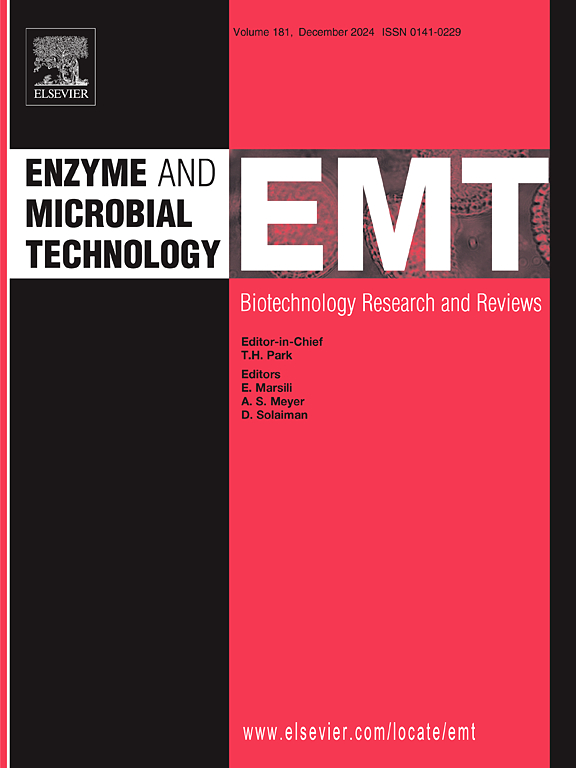蜡样芽孢杆菌抗铜绿假单胞菌n -酰基高丝氨酸内酯酶和青霉素酰化酶II:伽马辐射对其群体猝灭活性影响的计算机和体外研究
IF 3.7
3区 生物学
Q2 BIOTECHNOLOGY & APPLIED MICROBIOLOGY
引用次数: 0
摘要
本研究探讨了来自环境环境的ISM25菌株对致病铜绿假单胞菌的群体猝灭(QQ)活性。首先对分离物ISM25进行筛选,发现其同时存在AiiA酰基同丝氨酸内酯酶和青霉素酰化酶II基因。利用AutoDock Vina对接试验,研究了短链(<C8)和长链(>C12)同型丝氨酸内酯(hsl)的理化性质和QQ活性。在硅对接试验中,还研究了酰化酶II酶与碳青霉烯类抗生素之间的潜在相互作用。随后,以生物膜指数、AHLs分子和致病性铜绿假单胞菌美罗培南最低抑菌浓度为指标,评价ISM25粗蛋白提取物的体外QQ活性。该粗蛋白提取物能够水解致病性铜绿假单胞菌(P. aeruginosa)分离物产生的AHLs,以及参考的C12-HSL信号分子,也支持了硅对接分析的结果。暴露于ISM25粗提物后,生物膜指数显著下降(P <; 0.05),进一步证实了ISM25分离物表达的两种QQ酶及其在硅中的QQ活性。ISM25粗提物降低MIC,使铜绿假单胞菌对美罗培南增敏(P <; 0.05),提示含有酰化酶II的ISM25粗提物可与美罗培南联用而不影响药效。最后,在低于100 Gy的剂量下,ISM25暴露在伽马辐射中不影响其QQ活性,但在辐射剂量≥ 500 Gy时,QQ活性几乎被消除。本文章由计算机程序翻译,如有差异,请以英文原文为准。
Bacillus cereus N-acyl homoserine lactonase and penicillin acylase II against Pseudomonas aeruginosa: An In silico and In vitro investigations exploring the effects of gamma radiation on their quorum quenching activity
This study explored the quorum quenching (QQ) activities of ISM25 strain, sourced from an environmental setting, on pathogenic Pseudomonas aeruginosa isolates. The isolate ISM25 was first screened for the presence of both AiiA acyl homoserine lactonase and penicillin acylase II genes. The in silico investigation focused on examining the physiochemical properties and QQ activities in relation to both short (<C8) and long chain (>C12) homoserine lactones (HSLs) utilizing AutoDock Vina docking tests. Potential interactions between the acylase II enzyme and carbapenem antibiotics were also investigated during the in silico docking tests. Afterwards, the in vitro QQ activity of ISM25 crude protein extract was assessed against the biofilm index, AHLs molecules, and meropenem minimum inhibitory concentrations of pathogenic P. aeruginosa isolates. The findings from the in silico docking analysis were supported by the crude protein extract's capacity to hydrolyze AHLs generated by the pathogenic P. aeruginosa isolate, as well as the reference C12-HSL signal molecule. The notable decrease in biofilm indices (P < 0.05) following exposure to the crude ISM25 extract further corroborated the expression of both QQ enzymes by the ISM25 isolate and their in silico QQ activity. The crude extract from ISM25 lowered the MIC and sensitized P. aeruginosa to meropenem (P < 0.05), suggesting that ISM25 crude extract containing acylase II can be administered in conjunction with meropenem without affecting its efficacy. Finally, exposure of ISM25 to gamma radiation did not impair its QQ activity at doses below 100 Gy, however, QQ activity was nearly abolished at radiation dose ≥ 500 Gy.
求助全文
通过发布文献求助,成功后即可免费获取论文全文。
去求助
来源期刊

Enzyme and Microbial Technology
生物-生物工程与应用微生物
CiteScore
7.60
自引率
5.90%
发文量
142
审稿时长
38 days
期刊介绍:
Enzyme and Microbial Technology is an international, peer-reviewed journal publishing original research and reviews, of biotechnological significance and novelty, on basic and applied aspects of the science and technology of processes involving the use of enzymes, micro-organisms, animal cells and plant cells.
We especially encourage submissions on:
Biocatalysis and the use of Directed Evolution in Synthetic Biology and Biotechnology
Biotechnological Production of New Bioactive Molecules, Biomaterials, Biopharmaceuticals, and Biofuels
New Imaging Techniques and Biosensors, especially as applicable to Healthcare and Systems Biology
New Biotechnological Approaches in Genomics, Proteomics and Metabolomics
Metabolic Engineering, Biomolecular Engineering and Nanobiotechnology
Manuscripts which report isolation, purification, immobilization or utilization of organisms or enzymes which are already well-described in the literature are not suitable for publication in EMT, unless their primary purpose is to report significant new findings or approaches which are of broad biotechnological importance. Similarly, manuscripts which report optimization studies on well-established processes are inappropriate. EMT does not accept papers dealing with mathematical modeling unless they report significant, new experimental data.
 求助内容:
求助内容: 应助结果提醒方式:
应助结果提醒方式:


